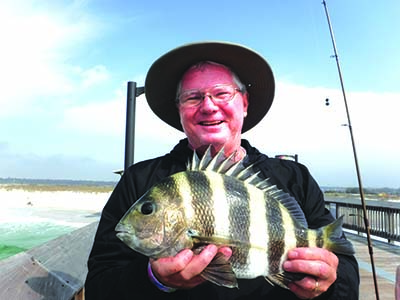Pier & Shore Fishing Outlook
Pier & Shore Fishing Outlook
By David “The Pierpounder” Thornton
Recently at least, there have been some signs of life in the cold, barren wasteland we refer to as the surfzone. The temperature of shallow coastal waters has languished in the upper 50s lately, which is a few degrees below average for late February. A warmer weather pattern would change that for the better as we move into March when we typically see the water begin rise back into the 60s. That would signal the beginning of more ‘springlike’ fishing patterns with more pompano, sheepshead, and redfish.
Sheepshead is likely still the best bet for shorebound anglers, as they are gathering in prespawn aggregations near the passes and bays before moving into the Gulf ‘en masse’. That’s when the fun really begins at the Gulf State Park Pier where dozens and even hundreds of these fat, feisty, tasty striped gamefish gather to mate and test the anglers’ tackle. Schools meander around the pier in calm weather to begin courtship and spawning rituals, meanwhile proving sport to anglers inclined to bring home dinner.
Most fishermen use live shrimp on medium heavy tackle rigged with a Carolina rig presentation. At times though, these notoriously finicky bait thieves prefer crunching on fiddler crabs dangled around the pier piling. Occasionally the schools may lay near the bottom where a live ghost shrimp is supreme bait. You might also pick up an occasional pompano, redfish, or black drum with ghost shrimp or live Penaeid shrimp this way. And a few speckled trout might start showing up around the pier and gulf passes as the shallow water warms.
With warmer water and strong tidal flow expected through most of this fortnight, fishing opportunities should abound along the beaches as well. Pompano will be the most targeted species with longer rods and set rigs placed along sandbar drop-offs and cuts being the best locations. It pays dividends to scout the beach and move around to find spots where you can get your rigs into the feeding zones for these free ranging fish. As the water warms, more pompano begin moving into the surfzone and they too begin gathering into prespawn schools. Though far from peak numbers, finding any kind of a pompano bite right now is another sure sign that spring has sprung along the coast.
Most surf anglers like the professionally tied double drop “pompano rigs” with beads or brightly colored floats near the hooks to get the attention of passing pompano. The hook is baited with an inch long piece of fresh shrimp, and/or Fishbites or Fishgum sold in local bait and tackle stores. These colorful synthetic baitstrips are designed to hang on the hook getting the attention of pompano or other gamefish and formulated to slowly dissolve in seawater. The scent (in several flavors) also helps draw pompano to your hook and further entice them to commit to biting. Just keep in mind that the total size of your bait presentation should not exceed the size of the mouth of the targeted fish. For pompano and other panfish with no teeth, this is no longer or bigger around than your index finger. In fact, a two-inch-long bait wad allows the pompano (or whiting) to inhale it all at once instead of repeatedly ‘pecking’ at a larger sized bait to break it into manageable pieces.
When the water is calm and clear the gaudier or heavier double drop rigs are often not as effective as a less visible presentation of thumbnail-sized pieces of dead shrimp or a beach ghost shrimp. These might be rigged on a Mortician rig, single drop rig or Fishfinder (“Carolina”) rig. The last of these is the stealthiest of all presentations in calm clear water and puts the bait on the bottom where the fish expect to find it. A little slack created by the 12 to 15 inch long 10-to-20-pound test clear mono or fluorocarbon leader is just enough to allow the unsuspecting fish to pick the bait up in its mouth and move away for a couple of seconds before the line comes tight. As it does, the fish panics and darts away which allows the number 4 or 6 kahle hook or small circle hook to find the corner of the mouth.
Fishing success may be far from a sure thing this time of year, but it seems we are slowly moving away from the dreaded winter doldrums as we move into March.
In a slow current a free line presentation is often more effective, and certainly covers more water faster. Splitshot weights (one or two) affixed on the line about a foot or so above the hook are very effective for drifting live shrimp or fiddler crabs into the strike zone. Though an increasing number of sheepshead anglers like the Bottom Sweeper (“Knocker”) and Free-Swinging style jigs. These are designed to move flat along the bottom while keeping the hook point facing up baited with a fiddler crab, or shrimp. It is a great presentation method for sheepshead staging on a sandy bottom, and offers great sensitivity of the light bite of a sheepshead.

